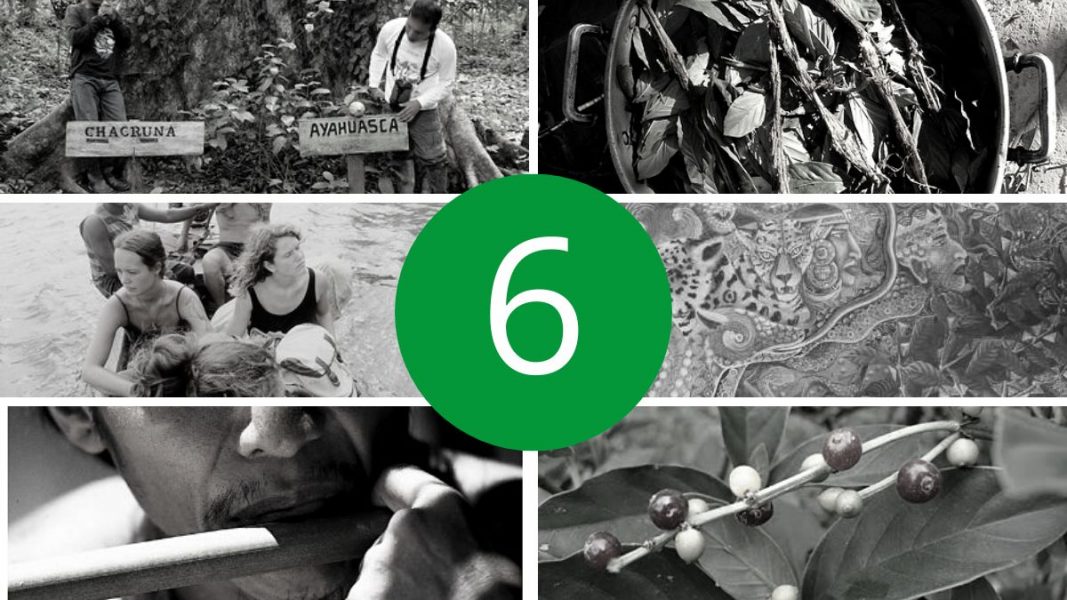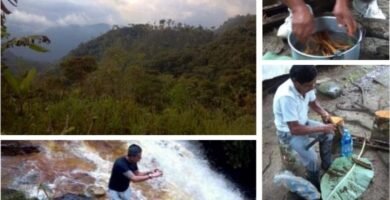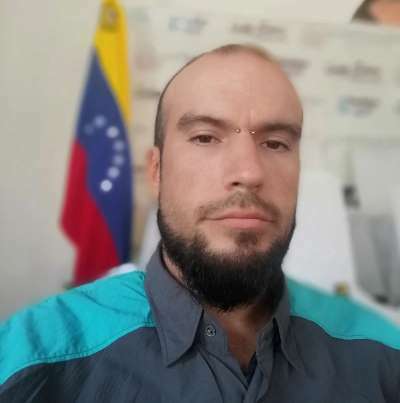
The consumption of ayahuasca is an ancestral practice of the indigenous people of the Amazon in America and is usually performed through a ceremony guided by a shaman, taita or healer, depending on the country.
Types of ayahuasca experiences
Each experience is totally personal and unique, it is only recommended to practice it under a guide and appropriate environment.
1. The traditional experience
The traditional experience is the shamanic type that is led by a shaman or taita, depending on the country where you are. These guides are prepared to perform the ceremony with the master plants according to their ancestral indigenous traditions.
This experience focuses on healing at a spiritual level, usually starting with a previous purging process that is performed to cleanse the body of toxins, the shots are taken at night by the fire and is accompanied by drum music, flutes, maracas, etc..
The type of music also varies according to each country, as do the chants performed by the shaman, which are known as ícaros. The entire ceremony is based on the indigenous cosmovision of healing.
2. The therapeutic experience
This more western practice is used as a form of psychotherapy and is used by psychologists and holistic therapists, prior to the intake of ayahuasca, an assessment of the patient is made, who usually seeks in the plant a form of personal growth and after this a work of integration is performed. They are usually done individually accompanied by music or just silence.
August 29, 2020

The Ayahuasca Failure Part II
August 27, 2020

The Ayahuasca Failure (Part I)
3. Religious takeover
This experience is practiced by syncretic churches in Brazil and is also found in various countries around the world, the best known of which is that of the Santo Daime whose members consume Ayahuasca about 4 times per month, under the tutelage of a guide or mestre, in the sessions the religious theme prevails but also healings are performed.
All rituals are practiced under strict rules to which participants must adhere such as the performance of hymns and They also practice sessions in silence and concentration and others in which the members ask questions to their teachers of philosophical and transcendental character. As they are closed communities, they are in charge of following up on their members, facilitating their integration processes. (ICEERS, 2018. Deciding to take ayahuasca? )
4. The experience of Graciela Rojas
Graciela Rojas is a yagé ceremony practitioner with three years of experience. He recounts his experience that begins in a hut known as maloka, with the accompaniment of drum music and a pleasant bonfire.
The taita begins to offer the infusion and after consuming it Graciela knows that she cannot know with what kind of vision she will begin her journey, she usually lies down by the fire and begins to perceive colorful images, she also hears voices inside her while trying to dominate her fears, if an unpleasant vision appears she usually says a prayer like the Our Father to make them disappear.
The taita and his team remain attentive to the needs of each participant until it is time to ask if they want to take a second cup of ayahuasca to make the experience last longer. Icarus which is a chant intended to protect and enhance the experience.
Graciela comments that because of her years of experience with ayahuasca she can take both intakes and control any negative vision or experience, she admits that these are all part of the process of renewal and healing that each intake entails.
5. The experience of William Burroughs
The story of the writer William Burroughs is almost iconic in conveying his experience with ayahuasca. With his writing skills, he described it as a kind of time travel. He says he felt a great wave of dizziness come over him and the place where he was standing began to spin. He compared its effect to being very drunk and going to bed and feeling the bed start to spin.
Another of Burroughs’ visions was to see the hut he was in with an archaic Pacific Ocean style appearance and to see in it the Moais or giant sculptures of Easter Island, as well as worm-like beings within a blue mist.
6. “Part of Existence”.
In his book “Part of the Existence” the biologist Julian de Almeida tells in first person his experience with Ayahuasca from his point of view as a scientist. The intake was under the guidance of a Shipibo shaman and his description begins by comparing the taste of the infusion to a wood-flavored yogurt.
A few minutes into the shot, visions of lights represented in filaments begin, which then transform into kaleidoscopes with very bright and sharp colors, all this amidst music with wind and percussion instruments. The shaman also recites chants in his native language, Spanish and Sanskrit.
The colored lights now go from being seen in two dimensions to three, and then enter the body through the wood-shaped face. It becomes difficult to remain seated due to a feeling that everything is moving all over the place. Then the visions of mythological animals and ferocious beasts would begin.
Nausea comes and goes but without ending in vomiting. The ceremony offers a support to overcome the experience thanks to the chants and music that serve as a support during the whole experience. These songs speak of the union of religions, the existence of one God and that time is the mind.
After the visions, the experience becomes contemplative, thoughts come about family, death, what has changed in life, the order and disorder of things. The shaman’s chants on the expansion of consciousness bear fruit.
Sources
Yagé ceremonies in Colombia. (2014, February 23). Sergio Interactive. https://www.usergioarboleda.edu.co/sergiointeractivo/uncategorized/ceremonias-yage-colombia/
Kraul, C. (2015, June 12). Great Read: Yage tourism: Vomiting and visions in Colombia, then peace. The Los Angeles times. https://www.latimes.com/world/great-reads/la-fg-c1-colombia-yage-tourism-20150612-story.html
ICEERS. (2018, December 20). Deciding to take ayahuasca? ICEERS. https://www.iceers.org/es/decidiendo-tomar-ayahuasca/
de Almeida, J. (undated). Ayahuasca – Part of existence. Partedeexistencia.com. Retrieved July 2, 2022, from https://partedeexistencia.com/ayahuasca-bolivia/.

Gerson Alvarado, Comunicador Social egresado de la ULA Táchira, Venezuela. Actualmente desempeñando funciones de Comunicador y Reportero Audiovisual. Fotógrafo, Músico y Ciclista. Apasionado por captar imágenes de paisajes y documentar historias.
This post is also available in:
![]() Español (Spanish)
Español (Spanish)
